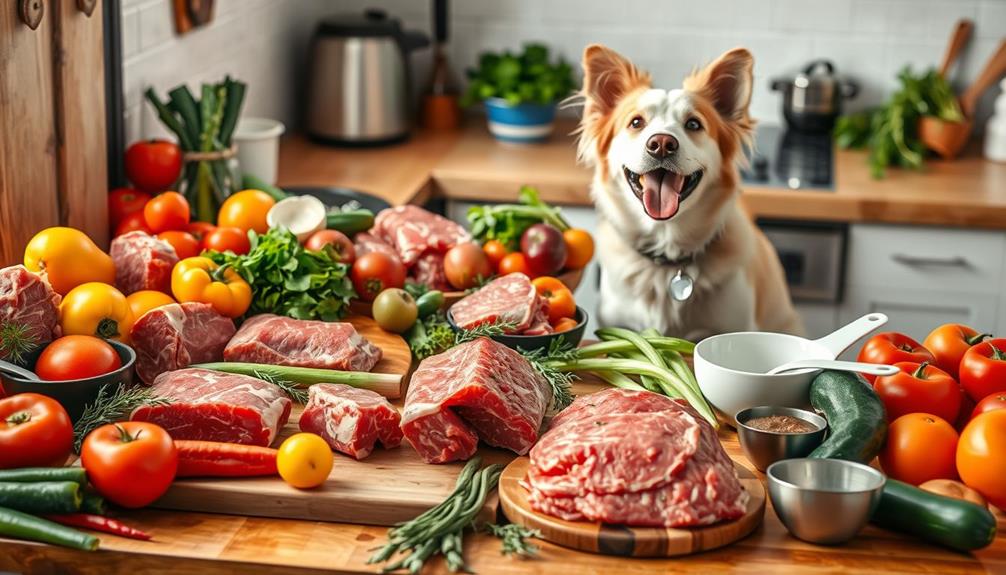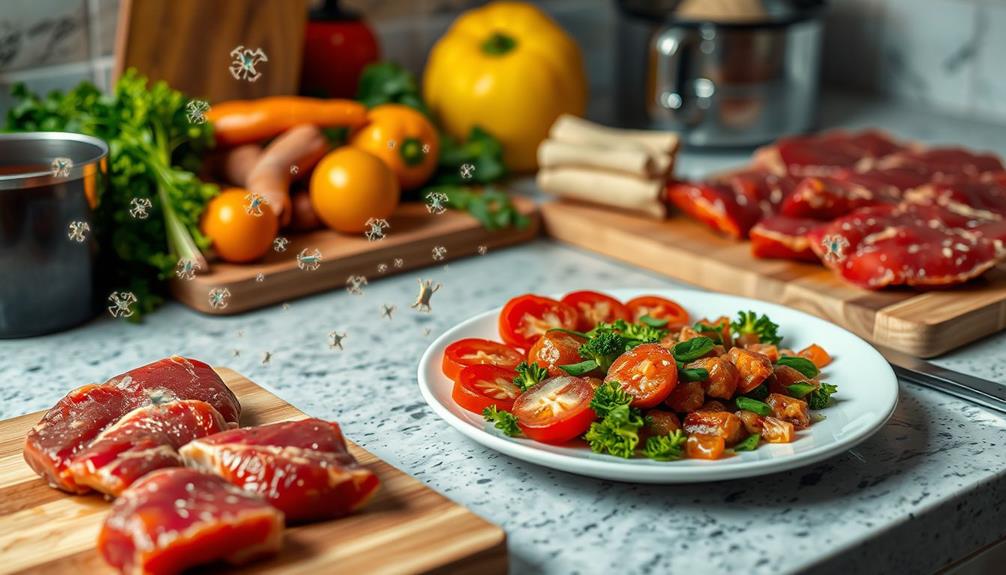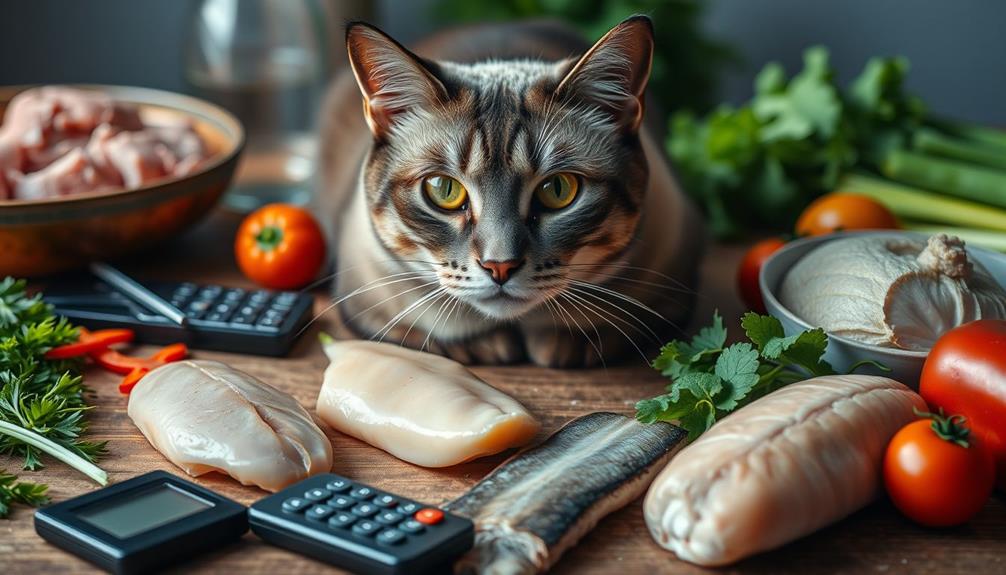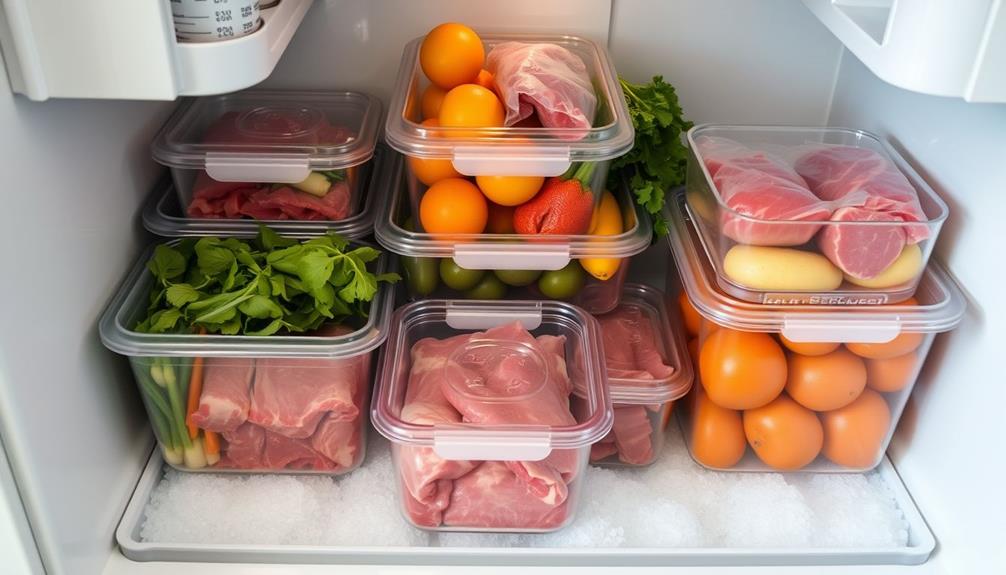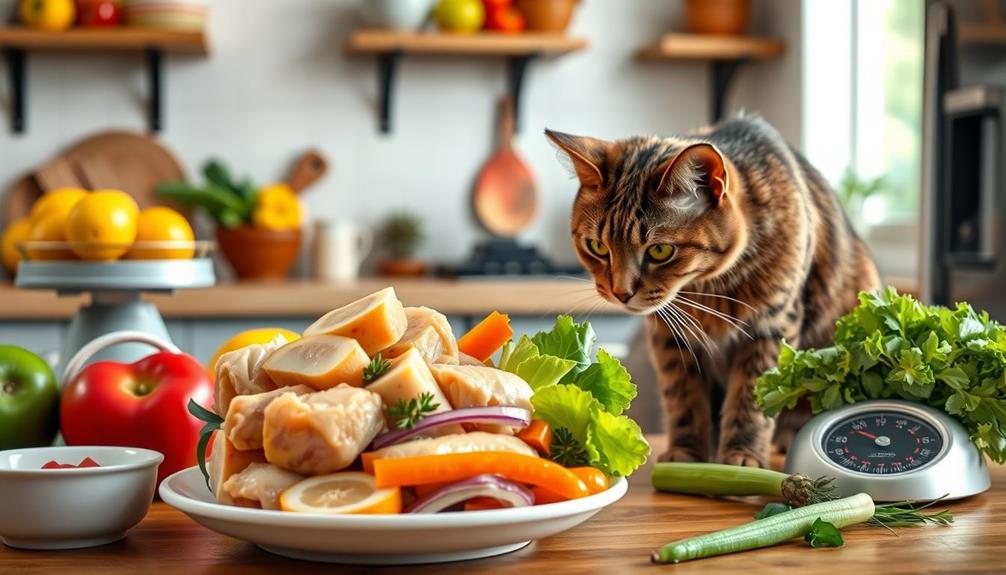Changing your dog to a raw food diet can improve their health and energy. Start with a gradual changeover over 7-10 days. Begin with a mix of 75% kibble and 25% raw food for three days. Then adjust the ratio, increasing raw food to 50% for a few days, and finally to 75% by day nine. Monitor your dog closely for changes in stool consistency and energy levels. Make sure to select high-quality ingredients and consult your vet if needed. With patience and care, you'll set the stage for a healthier, more vibrant pup, and there's much more to learn about enhancing their raw diet!
Key Takeaways
- Understand the raw food diet's foundation, focusing on uncooked meats, organs, bones, and a variety of fruits and vegetables.
- Choose between a cold turkey switch or a gradual transition over 7-10 days, monitoring your dog's reaction closely.
- Start with a 75% kibble and 25% raw food mix, gradually increasing raw food to 100% based on your dog's comfort.
- Keep track of stool changes and monitor for detox symptoms like vomiting or loose stools during the adjustment phase.
- Select high-quality raw food ingredients that meet AAFCO guidelines and consider tailored meal plans for balanced nutrition.
Understanding the Raw Food Diet
Understanding the raw food diet for dogs can be transformative for both you and your furry friend. This diet emphasizes feeding your dog uncooked meats, organs, and bones, closely mimicking their ancestral meat-based diet. A balanced raw diet not only includes a variety of proteins like beef, chicken, and fish but also incorporates raw fruits and vegetables to provide essential nutrients and fiber.
Additionally, just as with hamster care and costs, it's important to think about the nutritional components of your dog's diet to guarantee it meets their specific health needs.
When you shift your dog to raw dog food, you may notice benefits such as improved digestion and fewer digestive issues. Many pet owners report that their dogs experience reduced allergy symptoms and stronger immune systems. This can be attributed to the better nutrient absorption typically seen with a raw diet, leading to smaller, firmer stools compared to traditional kibble.
To facilitate a smooth shift, start by gradually introducing raw food into your dog's meals. Begin with 75% kibble and 25% raw food, slowly increasing the raw portion over about ten days. This careful approach helps your dog's digestive tract adjust to the change without causing upset.
Benefits of a Raw Diet
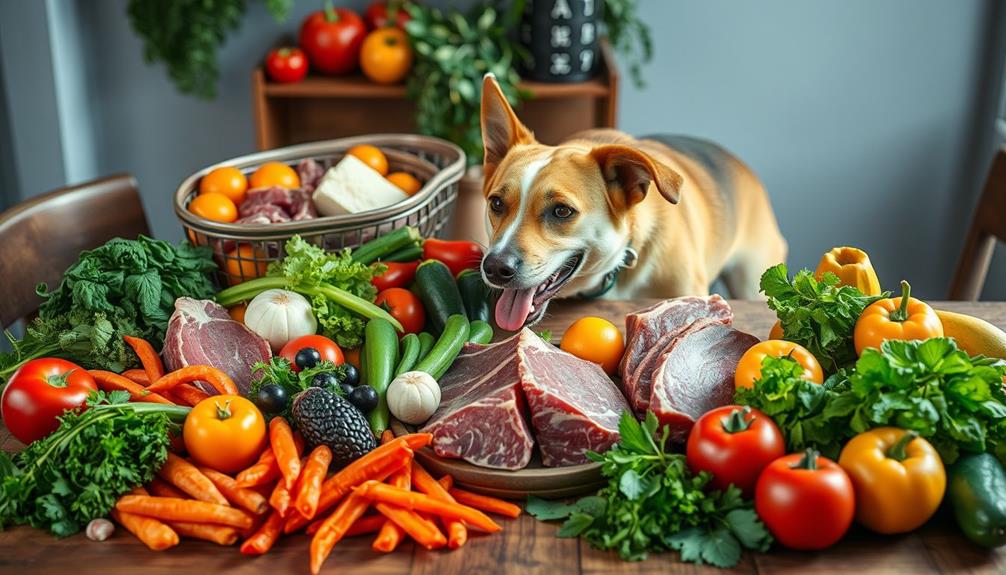
Switching to a raw food diet can bring numerous benefits for your dog that go beyond just improved digestion. Many pet owners notice an improved coat condition and healthier skin, with reduced shedding becoming a common perk. You might also find that your dog displays enhanced energy levels, leading to a more active and playful lifestyle. Additionally, incorporating a raw diet can support your dog's immune system and overall health, which is essential for preventing illnesses and maintaining liveliness common types of cold medications.
With a raw diet, you can expect better digestion and nutrient absorption, resulting in smaller, firmer stools. This indicates that your dog is efficiently utilizing the nutrients in their food. Additionally, many dogs experience reduced allergies and food sensitivities when changing to a raw diet. This can lead to fewer allergy-related symptoms, such as itchy skin or digestive upset.
Improved dental health is another significant advantage of a raw diet. Chewing raw bones helps reduce plaque buildup and promotes cleaner teeth, which can lead to fewer vet visits for dental issues.
Transitioning Methods Overview
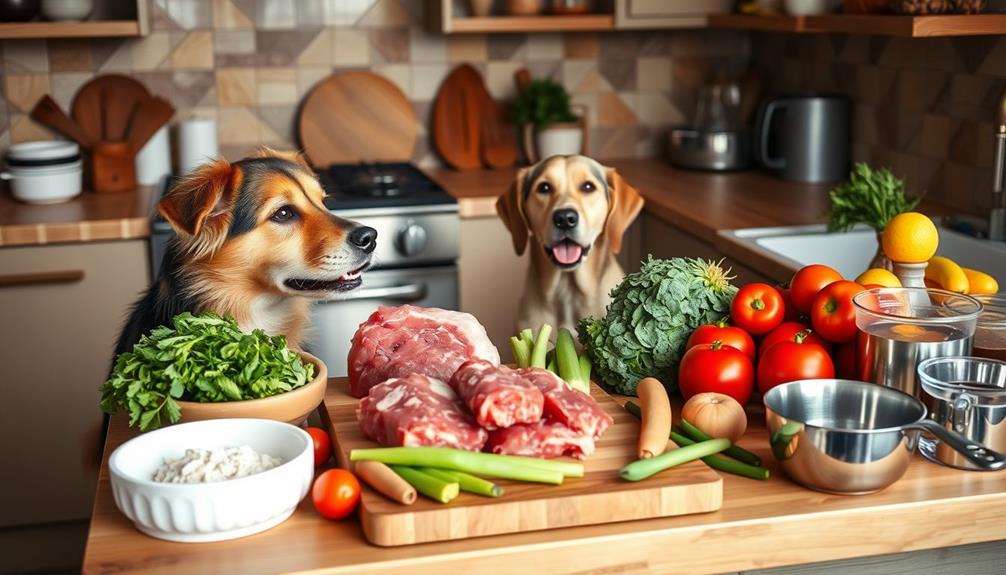
Shifting your dog to a raw food diet can be an exciting journey, but it's important to choose the right method for a smooth adjustment. You have two main options: the cold turkey switch or a gradual change.
Here's a quick overview of both methods:
| Method | Description |
|---|---|
| Cold Turkey Switch | Immediate change to a raw food diet; best for healthy dogs with no sensitivities. |
| Gradual Change | A measured approach over 7-10 days, adjusting kibble and raw food ratios. |
During the gradual change, you might start with 75% kibble and 25% raw, gradually increasing to 100% raw by day 10. Various techniques, like the Treat First Switch or Separate Meals Switch, can help ease your dog into this new diet.
It's essential to monitor your dog's reaction closely throughout the change period. Keep an eye on their digestive system and make adjustments based on stool consistency and overall behavior. Remember, some dogs may require a longer change period, especially older pups or those with sensitivities. When done right, changing to raw dog food can lead to a healthier, happier pet!
Gradual Transition Steps
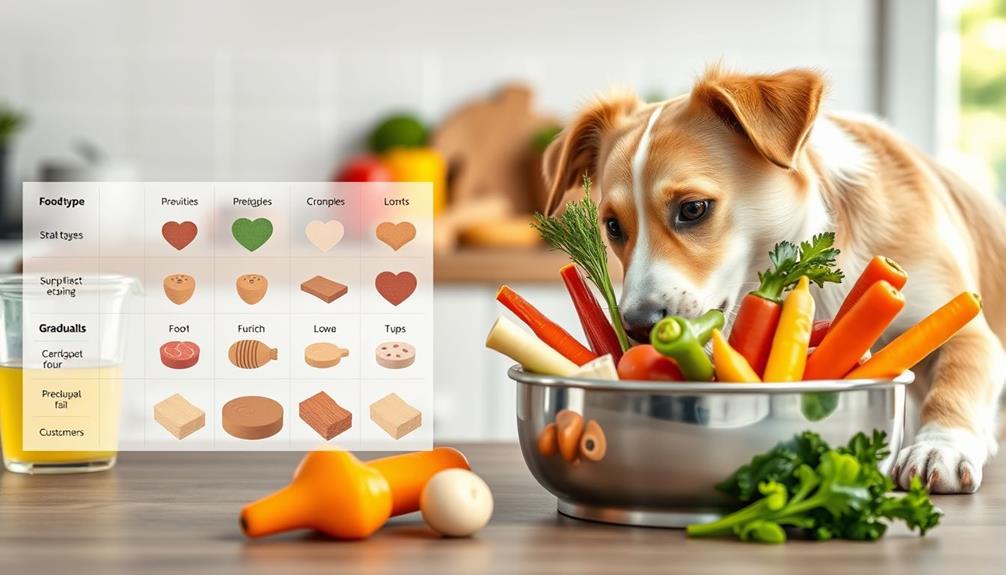
To start the gradual changeover, mix 75% kibble with 25% raw food for the first three days.
It's important to monitor your dog's reaction to the new diet, as certain healthy dog snacks can ease the changeover process.
Keep an eye on your dog's stool changes as you adjust the food ratios over the next week.
This careful approach helps your dog adapt smoothly to their new diet.
Starting With Kibble Mix
Often, dogs need a gradual adjustment when shifting to a raw food diet. Starting with a kibble mix is an effective way to ease your dog into this new feeding routine. For the first three days, mix 75% kibble with 25% raw food. This initial ratio allows your dog to acclimate without overwhelming their system.
Here's a simple guide to follow:
| Day Range | Food Ratio |
|---|---|
| Days 1-3 | 75% Kibble / 25% Raw |
| Days 4-6 | 50% Kibble / 50% Raw |
| Days 7-9 | 25% Kibble / 75% Raw |
| Day 10+ | 100% Raw |
During the shift, monitor your dog's willingness to eat and be patient with the adjustment period. Some dogs may require a longer time to adapt comfortably. As you gradually increase the raw food, keep an eye on their stool consistency; firmer stools often indicate a successful shift. If you notice any issues, don't hesitate to adjust the pace to guarantee your furry friend's comfort and health.
Monitoring Stool Changes
As you change your dog to a raw food diet, keeping an eye on their stool changes is essential for guaranteeing a smooth adjustment. Monitoring stool changes helps you gauge how well your dog's digestive system is adapting.
Initially, you might notice loose stools, which could indicate that your dog needs more bone content in their diet. This adjustment period can be similar to the developmental milestones assessed in children, where changes in behavior can indicate the need for further support. As they adapt, expect to see firmer and smaller stools.
During this detox period, some adjusting dogs may experience symptoms like mucus-covered stools. While these are generally not concerning, it's important to observe their severity.
Keep track of any changes in stool frequency and consistency; increased potty breaks are common during this adjustment phase.
If loose stools persist beyond a few days, it's vital to consult with a veterinarian. They can help determine if the raw food diet is suitable for your dog's individual needs.
Adjusting Food Ratios
Monitoring your dog's stool changes provides important insights as you begin adjusting their food ratios. It's vital to guarantee that your dog isn't only adapting to the new diet but also maintaining overall health during this change.
Start the adjustment by mixing 75% kibble with 25% raw food for the first three days. This helps your dog acclimate to the new diet while you observe their stool consistency and overall acceptance. After these initial days, gradually increase the amount of raw food to 50% for days 4 to 6. Keep an eye on your dog's appetite and any digestive changes during this period.
Understanding the importance of monitoring can help in making necessary adjustments.
For days 7 to 9, adjust the feeding ratio to 75% raw food, continuing to monitor how well your dog is adapting. By day 10, aim for a complete switch to 100% raw food, but remember that each dog may have a different adjustment timeline. It's imperative to be flexible and patient, as some dogs may need more time to acclimate.
Throughout this process, pay close attention to your dog's stool quality, as it indicates how well they're adapting to their new diet. If you notice any issues, consider slowing down the change to guarantee your dog's comfort and health.
Enhancing Raw Meals
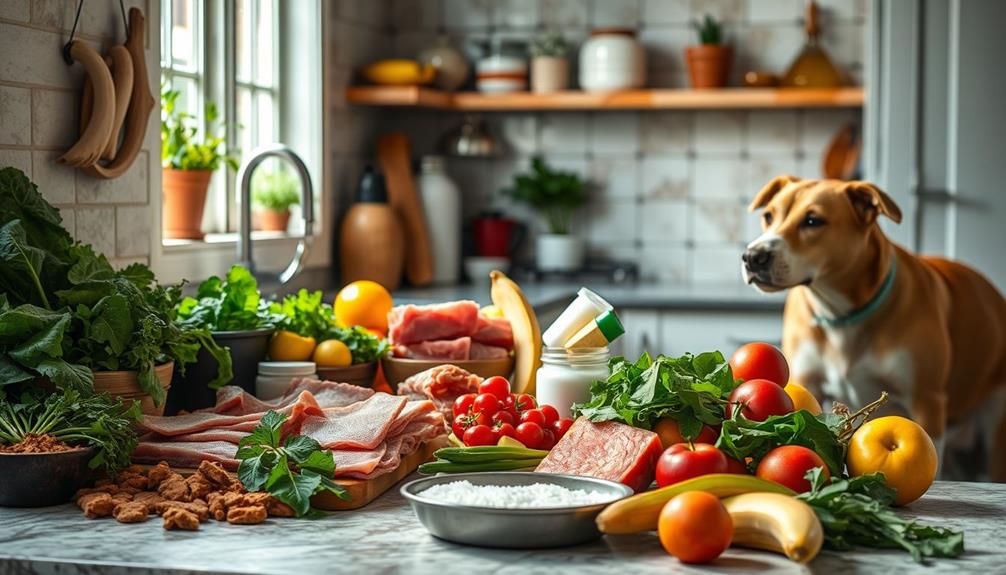
To make raw meals more enticing for your dog, consider adding flavorful ingredients like cheese or canned sardines.
Incorporating various brewing methods can inspire creative meal preparations, as experimenting with different textures and aromas is essential. You can also experiment with different textures and aromas by lightly searing the meat or incorporating raw fruits and veggies.
Observing your dog's reactions will help you tailor these enhancements to their preferences, ensuring they enjoy their new diet.
Flavor Enhancing Additions
Changing your dog to a raw food diet can be an exciting journey, and flavor-enhancing additions play an essential role in making meals more enticing. Incorporating natural elements like essential oils can also contribute positively to your dog's overall health, as certain oils have properties that support digestion and wellness, such as essential oils for respiratory health.
By incorporating these flavor enhancers, you can stimulate your dog's appetite and encourage them to embrace their new raw meals. Here are some great options to experiment with:
- Canned sardines for a boost of omega-3s and enticing flavors
- Low-sodium bone broth to add moisture and richness
- Goat's milk, which can be a creamy treat packed with nutrients
- Lightly seared meat to release appetizing aromas
- Fresh fruits and vegetables to introduce new tastes and textures
These additions not only make raw meals more appealing but also contribute to a balanced diet, introducing crucial nutrients.
Don't hesitate to experiment with different combinations to see what excites your dog the most. Over time, as they adjust to their raw food diet, you can gradually reduce the enhancements.
The goal is to create a delicious, nutritious experience that your dog looks forward to at mealtime!
Texture Variations
While altering your dog to a raw food diet, introducing texture variations can make mealtime more enjoyable and engaging. You can enhance your dog's meals by mixing in fresh food, like fruits and vegetables, which add crunch and excitement. Additionally, incorporating nutritional benefits like antioxidants from certain fruits can contribute to overall health.
Experimenting with different protein sources not only creates appealing textures but also helps guarantee your dog enjoys a balanced diet rich in diverse nutrients.
If your pup is a picky eater, consider adding canned sardines, low-sodium bone broth, or goat's milk. These ingredients can enrich the flavor of raw meals and encourage them to embrace adapting to raw. For an extra boost, incorporating cheese or your dog's favorite treats can greatly increase their interest in the new diet.
To further engage your dog, try lightly searing the meat initially. This technique helps release appealing aromas, making the meal more enticing. As your dog becomes accustomed to raw food, you can gradually reduce this step.
Aroma Release Techniques
Enhancing your dog's raw meals goes beyond just texture; aroma plays a significant role in making food appealing. To encourage your pup during the shift to raw dog food, focus on aroma release techniques that create enticing aromas.
Incorporating essential oils for skin conditions can also contribute to a more enjoyable mealtime experience for your dog by promoting overall health. Here are some effective methods:
- Lightly sear the meat before serving to reveal those mouthwatering scents.
- Gradually reduce searing as your dog adjusts to the raw food, shifting their preference to the raw aroma.
- Incorporate strong-smelling additions like canned sardines or goat's milk to enhance the flavor.
- Use low-sodium bone broth as a base or topper for added richness and aroma.
- Serve meals in a calm environment, free from distractions, to amplify the aroma release.
Monitoring Health Changes
As you commence the journey of shifting your dog to a raw food diet, it's important to keep a close eye on any health changes that may arise. Monitoring health changes is significant during this changeover. Pay attention to your dog's stool consistency; raw-fed dogs typically produce smaller, firmer stools. If you notice loose stools, it could be a sign that more bone is needed in the diet.
Additionally, many dog owners report positive shifts in their pets' energy and coat condition after adopting a raw diet, similar to the uplifting themes found in Blue Skies and Lemonade by Rhythm Failure.
Be alert for common detox symptoms like vomiting and bad breath. These usually resolve within a few days. Additionally, keep track of your dog's hydration levels. Raw food has higher moisture content, so your dog might drink less water, but always make sure fresh water is accessible.
Observe any changes in energy levels and behavior. Many dogs experience increased liveliness and improved coat condition after changing to a raw diet.
Regular vet consultations are important throughout this process. They can help assess your dog's health and nutritional needs, especially if severe symptoms arise.
Managing Detox Symptoms

Shifting your dog to a raw food diet can sometimes lead to detox symptoms, which are typically temporary but can be concerning for pet owners.
It's important to recognize and manage these symptoms effectively. Common issues include:
- Vomiting
- Loose stools
- Bad breath
- Mucus-covered stools
- Increased thirst
To aid in managing detox symptoms, consider incorporating plain canned pumpkin into your dog's meals. This can help firm up loose stools during the changeover.
Additionally, keep an eye on your dog's hydration needs; ensuring access to fresh water is vital since their needs may change.
If you notice your dog becoming lethargic or showing signs of severe detox symptoms, it's necessary to consult a veterinarian.
While mucus-covered stools may indicate detox, they generally resolve as your dog adjusts to the raw food diet.
Selecting Quality Raw Food
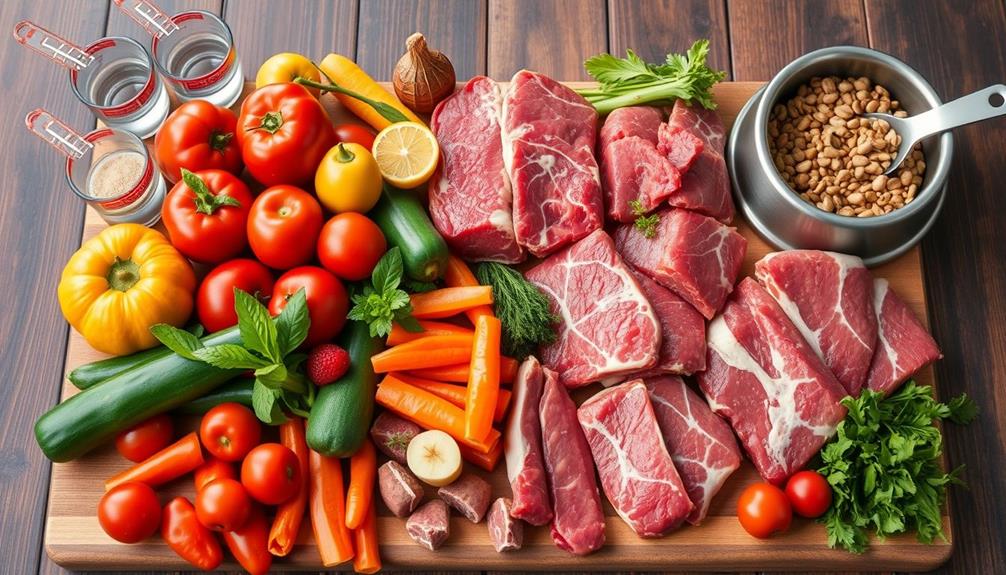
Choosing quality raw food for your dog is vital to guarantee they're getting the best nutrition possible. Start by prioritizing high-quality ingredients sourced from reputable suppliers. Look for raw food brands that use fresh meats and organ meats, free from fillers or artificial additives.
It's also important to make sure the meals you choose are complete and balanced, meeting AAFCO guidelines for nutritional adequacy. This certification reflects a brand's commitment to providing a healthy diet for your furry friend.
Don't forget to investigate the company's reputation. Reading customer reviews can give you insights into the brand's reliability and product quality. Additionally, check for any certifications or affiliations with pet nutrition organizations, as these can indicate a dedication to high standards.
Consider the preparation methods used by the manufacturer, such as cold-shipping and proper handling practices, to maintain food safety and minimize contamination risks.
Resources for Raw Feeding
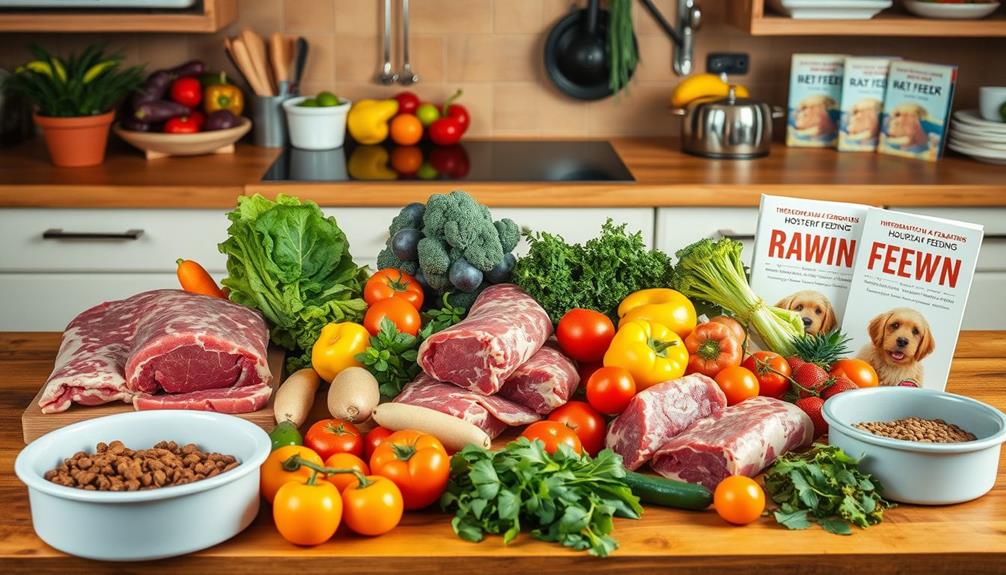
When shifting your dog to a raw food diet, utilizing available resources can make the process smoother and more manageable. Engaging with the right tools and communities can help you navigate the change while addressing your dog's specific nutritional needs.
Here are some valuable resources for raw feeding:
- Online Communities: Join groups like "The Pack" on Facebook to share experiences with fellow pet owners.
- Tailored Meal Plans: Consider services like Bella & Duke that deliver fresh, high-quality ingredients tailored to your dog's requirements.
- FAQs and Blogs: Explore educational content to tackle common concerns and get tips for successful raw feeding.
- Customer Support: Leverage support from raw dog food brands to customize your dog's diet effectively.
- Best Practices: Stay informed about nutrient considerations and potential health benefits through available literature.
Frequently Asked Questions
Can I Mix Raw Food With My Dog's Current Kibble Indefinitely?
Mixing raw food with kibble can be done temporarily, but it's not ideal long-term. Your dog's digestive system needs time to adjust, so consider altering gradually to a complete raw diet for better health.
How Do I Store Raw Food Safely to Prevent Spoilage?
Storing raw food's like safeguarding treasure; keep it in airtight containers, refrigerate or freeze immediately, and always check for expiration dates. This way, you'll protect your dog from spoilage and maintain meal quality.
Are There Any Specific Supplements Needed for a Raw Diet?
When feeding a raw diet, you might need specific supplements like omega fatty acids, calcium, or multivitamins. It's best to consult your vet to guarantee your dog's nutritional needs are fully met and balanced.
What Are the Signs of an Allergic Reaction to Raw Food?
"Better safe than sorry." If your dog shows signs like itching, swelling, gastrointestinal upset, or respiratory issues after eating raw food, it might indicate an allergic reaction. Consult your vet to guarantee their health.
Can I Feed My Dog Raw Bones, and Which Types Are Safe?
You can feed your dog raw bones, but choose safe options like beef or chicken necks. Avoid cooked bones, as they splinter easily, and always supervise your dog while they enjoy their tasty treat.
Conclusion
As you begin this journey to a raw food diet, think of it as planting a seed in your dog's health garden. With patience and care, you'll nurture their well-being, watching them thrive like vibrant blooms. Embrace the changes, celebrate the small victories, and stay attuned to their needs. Like a gardener tending to their plants, your efforts will yield a flourishing companion, full of energy and joy. Together, you're creating a beautiful, healthy life.

